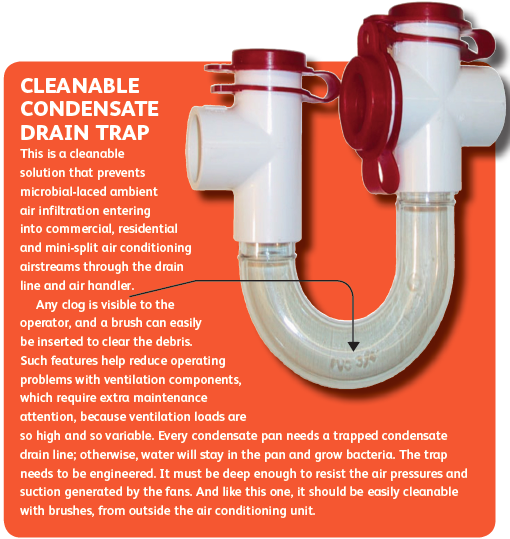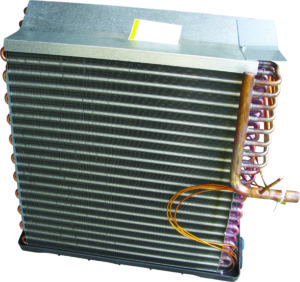CPI Industry accepts no liability for the views or opinions expressed in this column, or for the consequences of any actions taken on the basis of the information provided here.
Farhan Juratli looks at the situation of an increase in microbial growth owing to poor dehumidification, resulting from the improper design of the drain pans and condensate trapping and the equally improper design of the cooling coil, which impedes the carrying out of the much-needed exercise of regular cleaning and maintenance
This is the second part of the article published in the May 2017 issue of Climate Control Middle East, titled ‘Condensing the solution to a nutshell’. Read part 1 here
Water and moisture are major pollutants in our buildings. Moisture, in the presence of dirt and darkness, is an ideal condition for the growth of mould and mildew. Therefore, moisture control is a major strategy for maintaining good indoor air quality (IAQ) in a building.
Coils that are kept clean internally as well as externally can deliver maximum heat transfer efficiency. In addition, clean coils ensure an acceptable IAQ. The building air flow constantly passes over the coils, so their maintenance is important for ensuring the best possible IAQ.
In the last issue, we discussed the design requirement for adequate coil dehumidification. In this, the second part of the article, we will discuss the moisture carryover and associated IAQ problems, especially increased microbial growth, as a result of poor dehumidification or moisture carryover, and/ or poor maintenance.
FACTORS INFLUENCING MOISTURE CARRYOVER
Moisture carryover from cooling coils refers to the entrainment of water into the airstream, as a result of too high coil face velocity and/or dirty coil surfaces.
The factors influencing moisture carryover are…
Air velocity: For a given cfm of air, a reduction in coil face area increases coil face velocity over the coil tubes. The 2.5 m/s rule for sizing cooling coils is adequate to keep water droplets from leaving the outer edge of the discharge side of the coil (carryover). In fact, the design of the coil itself, with respect to fin spacing, fin design, fin material, tube spacing, coil height, coil cleanliness and the moisture level of the entering air, determines the maximum face velocity, after which carryover (blow off) will occur. These aspects may vary slightly from one manufacturer to another.
As air velocity and turbulence over the coil surface increases, the tendency for condensate to be carried off the coil surface into the air stream also increases. An increase in velocity also brings with it increased airflow resistance, which the fan must offset with increased horsepower; this must be balanced against heat transfer efficiency in arriving at a reasonable coil face velocity and fin/tube design.
Fin design, shape and number of fins:The fins, which are mounted on the tube, contribute most to the heat transfer, because they constitute most of the coil surface area exposed to the airstream. It is good practice to use coils with a maximum of 8-10 fins per inch (fpi). A higher fpi can have:
1) Moisture carryover at 2.5 m/s.
2) Higher air-side pressure drop
3) Insufficient space between fins for coils cleaning
However, you still can go up to 18 fpi, if the face velocity is below 2.0 m/s.
Spacing the fins closer together multiplies the surface area by permitting more fins per linear unit. Although the airside pressure drop may increase, the addition of fins extends the available surface area without affecting the overall size of the coil.
THE ADVERSE IMPACT OF MOISTURE CARRYOVER ON IAQ
When the moisture that is carried over into the air stream lands on a surface, it will cause any bacterial or fungal spores on the surface to become viable for growth and multiplication. Most building component surfaces have sufficient nutrient content to enable mould to reproduce. Thus, mould can amplify within a few hours on virtually any interior substrate surface in the presence of sufficient water.
It is important to note that biological agents may enter the building through outside air intakes. Due to their small size, they may not be filtered out of the airstream. Frequently, they settle in the cooling coil itself. If allowed to become wet and dirty, air conditioning ductwork can provide a fertile territory for bio-aerosols. The dust and darkness inside air distribution ducts, plus condensate moisture, all interact together to turn the vast surface area into breeding grounds for mould.

OTHER CAUSES OF IAQ PROBLEMS FROM COOLING COILS
A) Improper design of the drain pans and condensate trapping: ASHRAE Standard 62 requires a drain pan to be provided beneath all dehumidifying cooling coil assemblies. It also requires to limit water droplet carryover beyond the drain pan to 1.5 mL per m2 of face area per hour under peak sensible and peak dew point design conditions, considering both latent load and coil face velocity.
Standing water is not allowed, as the pan also must drain quickly and completely to prevent it from becoming an unhealthy pool of contaminants.
Failure to do so can lead to life-threatening illnesses and to damage to the property. To meet this requirement, the drain pan will generally be sloped to a recessed bottom drain outlet and shall be sloped at least 10 mm per metre from the horizontal towards the drain outlet. For the designer, this means the condensate pan must be sloped in two directions towards the drain connection, and it must have a proper trap – one that is deep enough to hold enough water to resist the fan pressure, and one which can easily be cleaned with a brush to remove accumulated dirt, twigs and feathers that somehow manage to bypass the filter and drain down the face of the coil along with the condensate. Drain pans will generally be constructed of galvanised, stainless steel or fire-resistant UV-rated plastic. Drain pans must be insulated to prevent the condensation of moisture on the outside of the unit casing. Fibreglass is prohibited for this purpose, as it will absorb water, lose its insulating properties, and provide a source for mould and bacterial growth. You should always remember that dirt plus water equals bacteria and fungi, which generate musty odours.
B) Insufficient service clearance for maintenance
If the owner wants good IAQ, the system and its components must be maintainable. And for that, they must be accessible. The HVAC designer must be allowed enough clear space beside, in front of and behind the components, for doors and windows for cleaning and inspection, and enough space to pull out filters and replace them.
Wherever you put your cooling coil, make sure there is enough room to pull it out. Simple as that!

Sooner or later, the coil will have to be removed for cleaning or to repair a leak; or it would have to be replaced. The ideal arrangement requires a space twice as wide as the coil. This allows the coil to be pulled inside the space without disturbing anyone. However, if such a space is not available, you may revert to the manufacturer’s requirement for service clearance.
The combination of dirt and moisture on cooling coils and standing water in drain pans can lead to odours. A dirty cooling coil/drain pan can be especially harmful to people with allergies and weakened immune systems. Breathing the air circulated across an unclean condensate pan can cause irritation of the eye, headaches, sinus-related issues and serious respiratory ailments. But often, the reason that coils and the interior of ductwork get dirty and that condensate drains get plugged is that filters are not changed regularly. And that is often because the designer has neither allowed any space to access and inspect the coil, nor enough space on the side or in front of the HVAC equipment to pull out the filters and replace them. Frequently, the designer does not have enough space to access and change components, sometimes because the architect and owner have decided that such valuable space must be used for other purposes!
It is always recommended to clean coils and drain pans once a year, as dirt or contamination on cooling coils will lead to excessive carryover. This is because dirt will restrict the movement of the condensate water to the drain pan, and as a result, the condensate water will be injected into the air stream instead of being drained into an active trap.
It is essential to measure the pressure drop and the air flow through the coil. If the measurement reveals an excessive decrease in air volume and an excessive increase in pressure drop, it is decidedly time to consider a replacement, since attempting to clean such a coil may only make matters worse.
There are some things that must always be included in coil piping. One of the most important features is a means of accurately determining pressure and temperature differences between the coil inlet and outlet. On coils over 25 square feet, it is important to install pressure gauges and thermometers on both the supply and return piping. On smaller coils, it is advisable to provide carefully located pressure/temperature taps for use with accurate insertion thermometers or pressure instruments.
In my view, replacing the analogue readout devices with the proper DDC sensors is still not sufficient. These ancient analogue devices aren’t expensive, and they provide an instantaneous local readout without having to lug a laptop up a ladder, unpack it and plug it in.
These devices provide the most important means of troubleshooting the coil. The pressure gauges will tell you if the coil has developed a blockage. The information you get from the thermometers and the circuit-setter or flow-control valve will allow you to calculate the actual delivered capacity of the coil.
A strainer on the supply line is an equally important requisite, irrespective of having strainers at the pumps. Strainers at the coils are cheap insurance. They will pick up rust flakes, welding and soldering slag, and other debris that might be left behind between the pump strainer and the coil. It’s a lot easier to clean a strainer than it is a coil.
A study published by ASHRAE1 revealed that good maintenance and operation practices, including coil cleaning, can significantly improve energy efficiency and IAQ performance of the cooling system in a building, such as reported there of 10-15%. The study indicated that the condensate water temperature approached the chilled water supply temperature from 3 degrees C to 4 degrees C before cleaning, as compared to from 1 degree C to 3 degrees C after cleaning. This represents a significant increase in latent heat transfer ability of the coil in the range of 10%. This indicates the ability of this coil “after cleaning” to being able to provide for better building dehumidification capacity control by delivering sub-dew-point air temperatures across the cooling coil.
Reference:
[1] Ross D. Montgomery, P.E., Study Verifies Coil Cleaning Saves Energy. ASHRAE Journal Vol. 48, November 2006.
____________________________________________________________
Farhan Juratli is LEED AP and Certified Energy Manager (CEM) with over 20 years of experience in the design, commissioning, retro-commissioning, evaluation and optimisation of HVAC systems for commercial and residential buildings. He was a lecturer in Thermodynamics and Heat Transfer at the American University of Sharjah in 1999 and Operation Manager at Carrier Corporation. He is currently a Project Manager – District Cooling. He can be contacted at juratli@hotmail.com
_____________________________________________________________
CPI Industry accepts no liability for the views or opinions expressed in this column, or for the consequences of any actions taken on the basis of the information provided here.
Copyright © 2006-2025 - CPI Industry. All rights reserved.